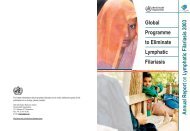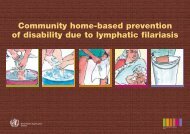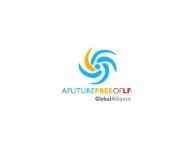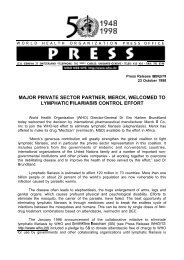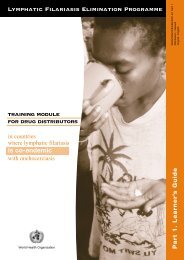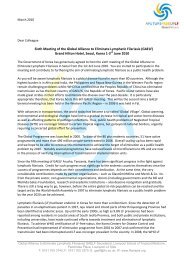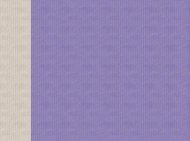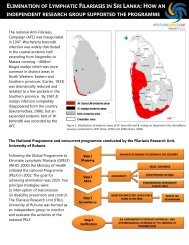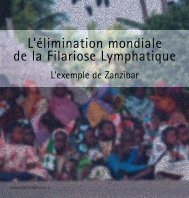English - Global Alliance to Eliminate Lymphatic Filariasis
English - Global Alliance to Eliminate Lymphatic Filariasis
English - Global Alliance to Eliminate Lymphatic Filariasis
You also want an ePaper? Increase the reach of your titles
YUMPU automatically turns print PDFs into web optimized ePapers that Google loves.
REPORT OF THE 6 TH GAELF MEETING, JUNE 2010<br />
Resourcing the strategy<br />
Chair: Professor Bernhard Liese<br />
African Development Bank<br />
Dr Tshinko B. Ilunga, Manager of the<br />
Health Division, African Development<br />
Bank (ADB), described the Bank’s health<br />
programmes, which assist regional<br />
member countries in addressing health<br />
problems, implementing health policies,<br />
and strengthening the health system. It<br />
also promotes investment in other sec<strong>to</strong>rs<br />
that have a direct bearing on health<br />
improvement (e.g., water and sanitation).<br />
The focus of the ADB’s on-going projects<br />
and programmes<br />
include public health<br />
promotion and<br />
health systems<br />
strengthening<br />
(through formulation<br />
of health policies and<br />
strategies;<br />
introducing reforms;<br />
and building capacity<br />
through training and<br />
infrastructure). Within the last five years,<br />
priority areas have included direct health<br />
investment through the public and private<br />
sec<strong>to</strong>rs and investing in environments that<br />
support health (e.g., food security, water<br />
and sanitation, communication<br />
infrastructure).<br />
Currently the health portfolio of the ADB<br />
is estimated at $690 million with 33 active<br />
investment projects in 30 regional<br />
member countries. The potential for<br />
greater impact exists, as committed<br />
resources are not fully utilized and<br />
countries tend not <strong>to</strong> request funding for<br />
health. Dr Ilunga emphasized that all<br />
available resources will be needed <strong>to</strong><br />
ensure that LF elimination is funded at an<br />
adequate level.<br />
USAID NTD Strategy 2010-2014<br />
Ms Angela Weaver, NTD Advisor for<br />
USAID, described the agency’s programme<br />
<strong>to</strong> address NTDs. This programme began<br />
in 2006, when the US Congress approved<br />
special “earmark” funding of $15 million<br />
per year. USAID awarded a competitive<br />
agreement <strong>to</strong> RTI <strong>to</strong> issue competitive<br />
grants <strong>to</strong> leading technical partners;<br />
support upscaling of MDA; help recipient<br />
countries gain access <strong>to</strong><br />
donated NTD drugs;<br />
contribute <strong>to</strong> lessons<br />
learned and best<br />
practices; and develop<br />
state-of-the-art <strong>to</strong>ols<br />
for moni<strong>to</strong>ring.<br />
The project started in 5<br />
countries (Burkina Faso,<br />
Ghana, Niger, Mali,<br />
Uganda – so-called “fast track” countries),<br />
and has expanded through a competitive<br />
grant process <strong>to</strong> include eight additional<br />
countries. The focus of USAID support has<br />
been <strong>to</strong> upscale PCT.<br />
USAID agrees with the programmatic<br />
advantages of an “integrated approach”<br />
<strong>to</strong> PCT. However, it is also important <strong>to</strong><br />
maintain a disease-specific focus; indeed,<br />
PCT may open opportunities <strong>to</strong> accelerate<br />
disease-specific targets.<br />
USAID funding for NTDs was increased <strong>to</strong><br />
$25 million in fiscal year (FY) 2009 and $65<br />
million in FY 2010. The goal of this<br />
investment is <strong>to</strong> expand integrated<br />
43



